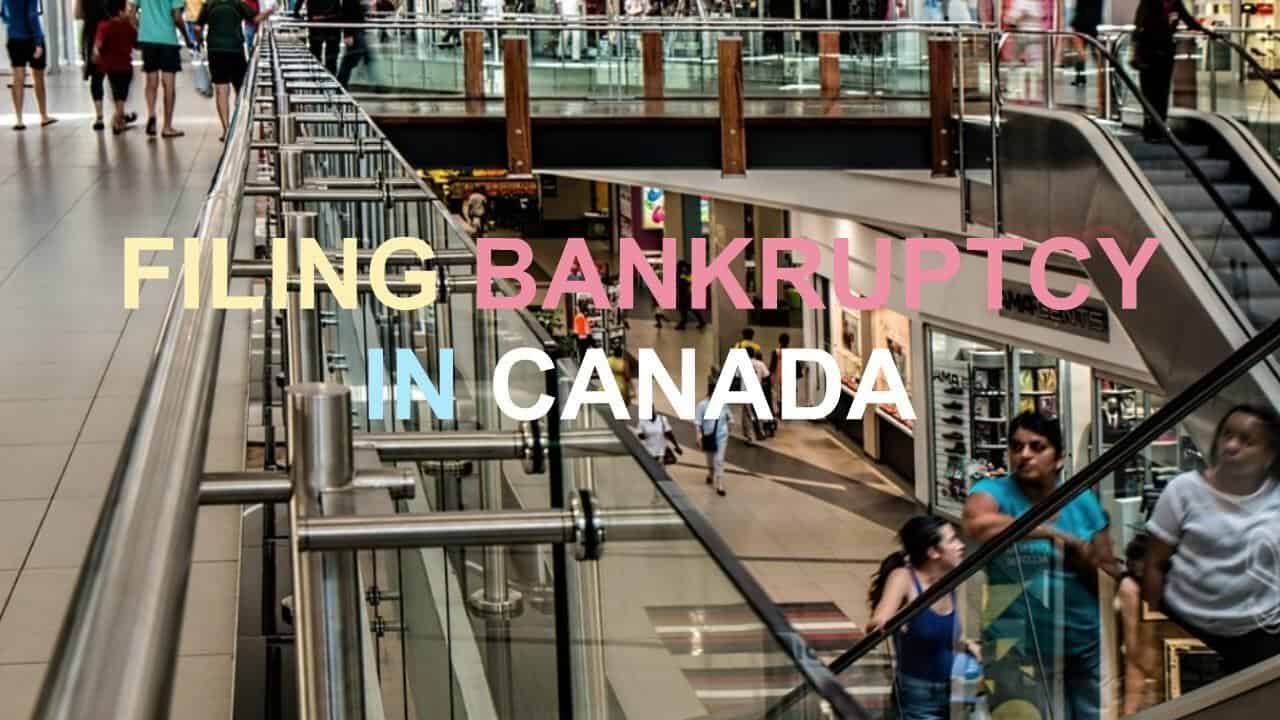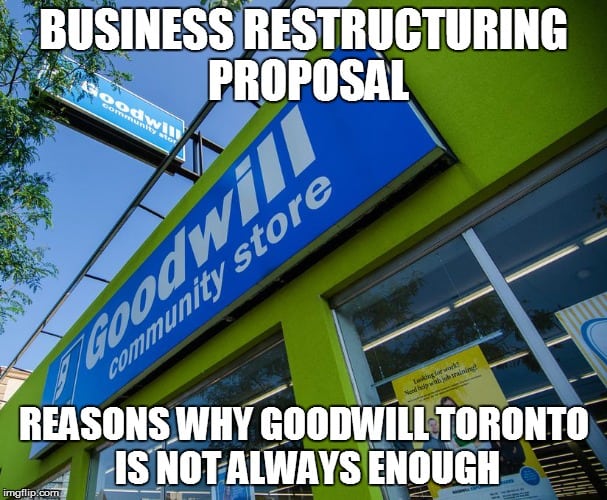If you would prefer to listen to an audio version of this filing bankruptcy in Canada Brandon’s Blog, please scroll to the bottom and click on the podcast.
Introduction
I read one article and one legal case over this past weekend that gave me the idea for this Brandon’s Blog about filing bankruptcy in Canada. The article was about the large US jewelry and accessories retailer Charming Charlie’s filing Chapter 11 bankruptcy for the second time in just over a year. In its 2018 filing, the retailer shed almost half of its 400 stores in a restructuring. Unfortunately, that was not good enough to save them. They have now filed again and announced they are closing their remaining stores.
The case I read is Old Navy (Canada) Inc. v. The Eglinton Town Centre Inc., 2019 ONSC 3740 (CanLII). This decision of the Ontario Superior Court of Justice was released on June 21, 2019. This case involves a retail tenant’s right to put into play rights it has as a result of a co-tenancy requirement under its commercial lease.
What Is Co-Tenancy Provision?
Simply put, a co-tenancy clause in retail lease agreements permits retail tenants to reduce their lease payments if key renters or a specific variety of lessees leave the retail premises. The idea being that certain tenants are major draws to a shopping centre and produce traffic for themselves and the other tenants. Those types of tenants are called anchor tenants.
A retail tenant agrees with the landlord to specific lease terms, especially the amount of rent to be paid. The commercial tenant agrees to those terms expecting a certain level of traffic in the mall or shopping centre. If anchor tenants leave, a co-tenancy provision allows a tenant to decide if it wishes to remain or not. If it decides to stay, then the lower amount of rent to be paid when a co-tenancy provision comes into play is meant to compensate the tenant for the lower traffic volume.
The Players
Old Navy is a famous retailer of clothes. It runs stores throughout Canada, the United States, and worldwide. Old Navy is a subsidiary of Gap Inc. (GAP), which is headquartered in San Francisco, California. Old Navy’s operations and stores are owned and operated by GAP.
GAP is the biggest specialty retailer in the USA. It has roughly 3,700 locations globally, consisting of 240 shops in malls and strip/power centres throughout Canada. GAP also owns the Banana Republic brand. Of the three, Banana Republic is taken to be on the top end of the GAP household of brand names, while Old Navy is the reduced level, affordable or budget brand name.
The landlord, The Eglinton Town Centre Inc., is owned and run by Lebovic Enterprises, a major Canadian property developer with its head office in Toronto, Ontario. Among others, it owns and runs the “Power Centre”, situated at Eglinton Opportunity East (the Centre).
The Old Navy Canada Lease
The Old Navy Canada lease, of course, had many terms in it. It included a co-tenancy provision. The clause named the key retailers (Key Shops) and their square footage. The Key Shops are the following retailers with the flooring area indicated:
| Key Shops | Square footage |
| Cineplex | 68,000 sf |
| Roots | 6,545 sf |
| Globo Shoes | 12,084 sf |
| Danier Leather | 6,548 sf |
Although the co-tenancy clause had various alternative remedies in it, all of them are not essential for you to know for the purpose of this Brandon’s Blog.
It is important for us to know that the co-tenancy section consisted of three main parts: (i) the number of Key Shops; (ii) a gross leasable area test; and (iii) a requirement for the landlord to advise the tenant in writing when a co-tenancy failure has actually happened.
Simply put, if the co-tenancy provision kicked in Old Navy Canada had the option to either:
- Shut down its store and leave on proper notice to the landlord; or
- Remain and pay a lesser “Alternate Rent” for the period that the co-tenancy issue remained unresolved.
The Danier Leather bankruptcy
Danier Leather (Danier) was a prominent Canadian seller of leather clothing and related leather items. The landlord entered into a lease with Danier for a preliminary 10-year term from June 10, 1999, to June 9, 2009. Danier’s lease was renewed in 2009 and Danier continued to be a renter of the Centre up until 2016. Danier’s premises of 6,548 square feet of space was out of a total of 285,425.37 square feet of gross leasable area in the Centre. Danier’s retail outlet represented just 2.3% of the gross leasable area.
Danier was a public company. Its shares were traded on the Toronto Stock Exchange. Nonetheless, public filings showed that Danier had been battling financial issues since 2014. Decreased earnings and yearly losses were unfortunately now its norm.
The negative operating results were thought to have been attributable to a change in the preferences of the buying public. There was a sentiment among some people to stop wearing leather items and apparel. On February 4, 2016, Danier submitted a Notice of Intention to File a Proposal (NOI) under the Bankruptcy and Insolvency Act, R.S.C., 1985 c. B-3.
Certainly, Danier’s insolvency was major news in the retail market. It was publicly reported in the nationwide media. At the time of the NOI filing, Danier operated 84 stores throughout Canada. Every one of the shops was leased. Ultimately, nonetheless, Danier determined not to submit a proposal and instead made an assignment in bankruptcy. A receiver was also appointed over Danier to liquidate the shops. Danier continued running until July 2016.
Definitely, every one of the occupants at the Centre, including the local staff of the Old Navy shop, would have recognized that Danier was conducting a going out of business inventory sale. It was unclear if anyone from Old Navy Canada told this to its senior management at the GAP.
Throughout the duration of the closing of the Danier outlet, the various other retailers at the Centre were growing. The Centre’s construction had long been completed and was well over 90% rented at the time of Danier’s insolvency. Cineplex was drawing audiences daily. The remaining stores in the portion of the Centre in which the Old Navy shop was located, across the parking area from the Danier outlet, were all operating. There was no proof they were not operating well and profitably.
The Dispute
The landlord believed that the closure of Danier had no material impact whatsoever on traffic at the Centre or on Old Navy’s sales. Given its interpretation of the co-tenancy requirements, the landlord ruled out that a co-tenancy failing had actually occurred. Therefore it did not provide any notice to the Old Navy care of GAP.
By September 15, 2016, GAP asserted they had ultimately found out about Danier’s filing bankruptcy in Canada. Thus, Old Navy issued a Notice of Co-Tenancy Failure to the Landlord and took the view that:
- Danier’s bankruptcy constituted a “co-tenancy failure” under the lease;
- that the landlord had breached the lease by not advising Old Navy of Danier’s bankruptcy; and
- that Old Navy was, as a result, exercising its “right” under the lease to pay the lesser rent to the landlord, retroactive to May 1, 2016.
The landlord argued that the Centre was in co-tenancy failure as a result of the closure of Danier and stated that if the current lease was not paid, the landlord would declare Old Navy Canada to be in default under the terms of the lease.
Various communications took place between lawyers for the landlord and Old Navy Canada. The landlord also kept them up to date on discussions it was having with various potential retailers that would be interested in either the Danier space or larger premises. One such retailer was a global party supply store chain. Another, that ultimately entered into a lease and began operating in the Centre, was a retailer of pets and pet products.
Old Navy Canada, through its parent the GAP, took the position that only a retailer of upscale clothing like Danier was, would be a suitable replacement. It also stated that it had a corporate policy not to be located in shopping centres that had a pet retailer as a tenant.
It turns out that assertion was untrue. The landlord produced evidence that there is a power centre in the west end of Toronto where the opposite is true. That centre was the Stock Yards Village, where the anchor was Target Canada until it failed several years ago. There is an Old Navy store operating in that shopping centre along with a PetSmart retail outlet. This contradicted Old Navy Canada’s and the GAP’s position on suitable co-tenants.
The landlord and Old Navy Canada continued to agree to disagree. Old Navy Canada continued to pay the normal rent but under protest. Ultimately, Old Navy Canada launched the litigation against the landlord looking for reimbursement of rent that it asserts to have actually overpaid to the Landlord.
The Court’s decision
The Court went through a complex analysis of legal precedents that are beyond the scope of this Brandon’s Blog. After careful consideration of the lease, the issues involved and precedent case law, the Judge decided:
- Old Navy’s interpretation of the provisions of the lease for the co-tenancy requirements is rejected.
- He accepted the landlord’s interpretation of the relevant terms as being the most objective.
- GAP/Old Navy’s evidence which was speculative.
- It was not sensible for GAP/Old Navy to anticipate to be able to occupy the facilities for the rest of its lease term without paying proper rent, merely because of a technical issue that had no noticeable effect on its operations.
- The landlord acted throughout in a commercially reasonable way.
Summary
What this case shows is that the bankruptcy of a retailer may very well invoke co-tenancy rights. However, it is not the bankruptcy that is the determining factor. Rather, it is the terms of the co-tenancy clause and its formulas contained in the clause that we have to look to. As seen in this example, the breach was not just because one of the Key Shops no longer operated. The terms of the Old Navy Canada Lease also forced a gross leasable area calculation to be performed. If the gross leasable area test was not met, then there was no breach.
Is your company experiencing financial problems? Are you on the brink of insolvency just like Danier was? Don’t wait until it is too late to properly restructure your company’s financial affairs. You don’t have to be another one filing bankruptcy in Canada.
As a Trustee, we are the only professionals licensed, authorized and supervised by the federal government to offer insolvency advice and to implement solutions under the Bankruptcy Act Canada. We will help you to select what is best for you to free you from your debt issues.
Call the Ira Smith Team today so we can eliminate the anxiousness, tension, discomfort and pain from your life that your cash problems have caused. With the unique roadmap, we develop just for you, we will promptly return you right into a healthy and balanced problem-free life.


